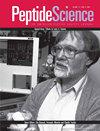主要机械力-化学相互作用 "相互作用是阐明折叠机制的工具
IF 1.7
4区 生物学
Q4 BIOCHEMISTRY & MOLECULAR BIOLOGY
引用次数: 0
摘要
肽和蛋白质的折叠严格依赖于特定氨基酸序列所携带的 "化学信息"。本研究将三种多肽(PDBs:2jof、1res 和 1prv)作为模型系统进行研究,以评估它们的折叠特征,从而进一步了解在更广泛的折叠过程中发挥作用的机制。本文提出了一种新的物理化学分析方法,重点关注化学相互作用及其相关的机械力,我们相信这些力是驱动折叠的决定性因素。通过这种方法,我们预测了三种多肽的构象,并将结果与实验测定的结果进行了比较,结果在结构上基本一致。为了进一步支持我们的计算和结构结果,我们还进行了分子动力学模拟。在这三个模型中,我们证明了每个氨基酸残基与其相邻残基的相互作用是形成三维稳定原生结构的关键决定因素。这篇文章提供了初步证据,证明折叠是通过在残基之间建立化学相互作用而产生的机械力发生的,而这种相互作用又是肽链每个位置上存在的每个特定氨基酸所特有的。本文章由计算机程序翻译,如有差异,请以英文原文为准。
‘Main Mechanical Forces‐Chemical Interactions’ Interplay as a Tool to Elucidate Folding Mechanisms
The folding of peptides and proteins is rigidly reliant on the ‘chemical information’ carried by the specific amino acid sequence. In this study, three polypeptides (PDBs: 2jof, 1res and 1prv) were investigated as model systems to assess their folded features, thereby enabling further understanding of mechanisms that play a role in regulating the folding process more widely. A novel physico‐chemical approach of analysis is proposed herein, focusing on chemical interactions and their related mechanical forces that we trust are determinant to drive the folding. Through this methodology, we have predicted the conformations adopted by the three polypeptides and compared the outcomes to those experimentally determined, achieving a substantial structural agreement. Molecular dynamic simulations have been carried out to further support our calculations and structural results. Within the three models, we demonstrate that the interaction of each amino acid residue with its neighbour residues is a crucial determinant for the formation of the 3D stable native structures. This article provides initial evidence that the folding occurs by means of mechanical forces developed upon establishing chemical interactions amongst residues, which, in turn, are peculiar to each specific amino acid present in each position of the peptide chain.
求助全文
通过发布文献求助,成功后即可免费获取论文全文。
去求助
来源期刊

Peptide Science
Biochemistry, Genetics and Molecular Biology-Biophysics
CiteScore
5.20
自引率
4.20%
发文量
36
期刊介绍:
The aim of Peptide Science is to publish significant original research papers and up-to-date reviews covering the entire field of peptide research. Peptide Science provides a forum for papers exploring all aspects of peptide synthesis, materials, structure and bioactivity, including the use of peptides in exploring protein functions and protein-protein interactions. By incorporating both experimental and theoretical studies across the whole spectrum of peptide science, the journal serves the interdisciplinary biochemical, biomaterials, biophysical and biomedical research communities.
Peptide Science is the official journal of the American Peptide Society.
 求助内容:
求助内容: 应助结果提醒方式:
应助结果提醒方式:


